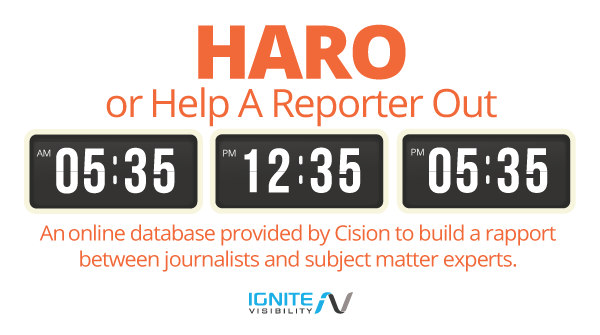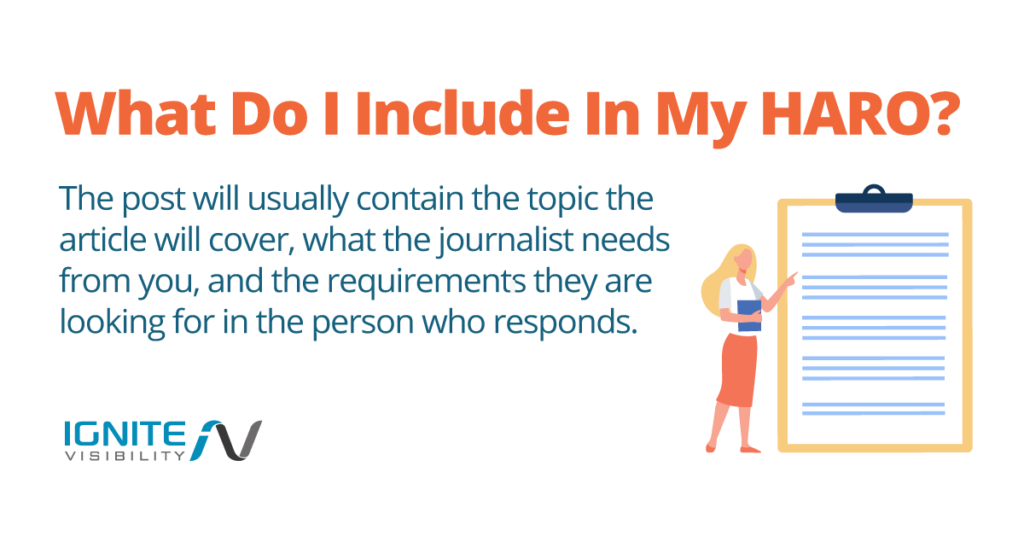 What is HARO — help a reporter out?
What is HARO — help a reporter out?
How are brands and journalists using this strategy to strengthen their reputations, build connections, and increase their coverage?
More importantly — how can you use them to your advantage to boost your brand awareness and increase your SEO rankings?
The answers to these questions, and more, are in the article below. Let’s get started.
What is HARO?
HARO or Help a Reporter Out is an online database provided by Cision in an effort to build a rapport between journalists and subject matter experts. It connects experts with writers and builds the relationships between the two, making it easier for writers to produce well-rounded and well-researched articles.
The platform has over 1 Million sources and 75,000+ journalists and bloggers. It is used by mainstream media giants such as Reuters, The New York Times, The Wall Street Journal, Time, ABC, and more.
Journalists and bloggers can submit queries, or requests, to HARO to get assistance with their research tasks. Cision then posts the queries for their network of brands, experts, and content sources.
The queries are posted three times a day: 5:35 a.m., 12:35 p.m., and 5:35 p.m. Brands and subject matter experts can then reply to these queries.
This encourages journalists and bloggers to utilize more well-rounded research while also helping brands and experts get well-earned media coverage.

HARO – Help a Reporter Out
What is in a HARO Query?
Each HARO query details exactly what a journalist is looking for. The post will usually contain the topic the article will cover, what the journalist needs from you, and the requirements they are looking for in the person who responds.
When drafting your response to a HARO, it’s important to pay particular attention to the requirements section and only reply to queries that fit your expertise.
Journalists who post HAROs are often doing so because they need information quickly. They will also probably get a lot of pitches. Don’t waste their time (or yours!) by responding to requests that you aren’t familiar with or can’t add value to. Doing this will earn you a reputation that you don’t want.

What Do I Include in My HARO?
How To Respond to a HARO Query Effectively
Now that you have the basics of what a HARO— help a reporter out — is, let’s talk about how to respond to a HARO query.
In addition to paying attention to the requesters’ requirements, pay attention to their audience. Who is the article for? Who are they trying to reach? What message are they trying to portray? Write in persuasive rhetoric that will grab the attention of the journalist who submitted the query but also resonates with their proposed audience.
A good way to break this down is to use the modes of persuasion — ethos, logos, and pathos — when writing your pitch. Persuade the journalist to pick your pitch by showing them how your information will persuade their audience to trust in their piece in return.
Personally, I like to incorporate all three modes of persuasion in order to make each HARO response as compelling as possible.
Ethos
Ethos refers to ethics and is used to establish credibility.
In this case, you’ll use ethos to establish your own credibility. Why should the pitcher trust your expertise? How did you learn what you learned and why should they listen to you over the other pitches in their inbox? You can establish this in a variety of ways including industry status, professionalism, and brand awareness.
Because audiences are more likely to believe statements and facts from credible sources, it is important to establish ethos on the platform. Respond to various opportunities to help establish your credibility and thought leadership within your niche.
If you are responding on behalf of a client or other presenter, use their authority to an advantage. Always use quotes in your responses. Sending press releases or other self-promoting content does not establish credibility and is prohibited by the platform’s rules.
If you are relatively new in your field and still building your brand awareness, you can use evidence to support your response. If the evidence is on your side, your credibility is harder to challenge.
Logos
Logos correlates to the speaker’s logic or reason behind their argument.
This portion of your persuasive pitch is the most important part because it is the actual content — the meat and potatoes of your piece. Craft your content in a way that answers the query while also showing that your words can be trusted.
Providing evidence or proof to support your claims is crucial when you’re responding to a HARO. Journalists’ and writers’ reputations are on the line and they do not want to make unsubstantiated claims. You need to provide them with easily digestible and researchable information that they can use in their article to support the information in their writing.
Providing evidence is also important from a reader audience standpoint. When you’re writing out your logic, you don’t just want to respond to the query. Prove your logic to your audience and help them realize why this information is important to them. As you write out your response, be sure to leave the audience with research that is relevant to or resonates with them.
In short, layout your logic in a way that is supported by evidence, easily researchable, and relatable to your audience.
Pathos
The last mode of persuasion to consider is pathos. This is where the emotions of your audience come into play. Emotions are important to both the journalist who submitted the query and their end reader.
Most queries get a lot of responses and you’ll want your audience to connect to you and your response, to increase the odds that they will reach out to you. It is important to realize how much text and copy actually matter and just how much they can play into one’s emotions.
Harness the power of a good quote to capture and hold your audience’s attention. Doing so increases the likelihood that your brand and message will be added to a potential article. Providing quick quotes, or soundbites draws the attention of the journalist by giving them content they can use.
Tips & Best Practices
Responding to HAROs, or Help a Reporter Out, are one of the best ways to build credibility for your brand. Being quoted in an article, especially one featured on a mainstream media platform, will bring your brand a reputation of trustworthiness that money can’t buy.
While you’re diving into the world of HAROs, keep in mind that, while this is an easy and free way to build your reputation, it is also a long game.
This level of visibility is unmatched but it can also be crowded. It could take a while to build your authority, get noticed and eventually be selected to be featured in the articles attached to the queries you’re responding to.
In conclusion, remember these aspects when you’re responding to a HARO:
- Start with a catchy title! You will only have a few seconds to grab your reader’s attention.
- Remember your audience — both of your pitch and of the journalist’s piece.
- Time is of the essence so submit your pitch quickly.
- Don’t submit sloppy work! Be sure to proofread and edit, even within an expedited time frame.
- Stay on topic and don’t submit fluff pieces. Off-topic and unsolicited submissions can actually get you banned from the platform as they go against HARO’s rules.
- Get to the point quickly. At most, your pitches should be 300 words.
- Attachments are automatically rejected in an effort to protect journalists from viruses and malware, so remember to submit your pitch as a Google doc or a Dropbox link.
- Make it easy to get in contact with you and include all forms of communication from your phone number and email address to your website and social media handles.
- No one likes to be spammed! Use this as a way to build actual relationships with the media sources that are looking for responses.
- Reuse your content! Just because your HARO doesn’t get accepted by the query you submitted doesn’t mean you can’t use it as content on your own social media, blog, or website. Just make sure you wait a month or so to really ensure that you won’t be selected for or quoted in an upcoming article.
Wrapping Up
Becoming a trusted voice in your industry all depends on how visible you are.
We’re big believers in using HARO and often utilize HARO pitches for our clients. We have personally seen how being selected for an article through HAROs will build brand awareness and credibility and improve backlink profiles exponentially.
If you want to start to benefit from the free exposure that HAROs can bring you and your brand but the process seems overwhelming, reach out to one of our experienced marketing professionals.
Together, we can find queries that match your brand’s area of expertise, and craft pitches that will grab the attention of your audience to increase your odds of being featured in an article.
